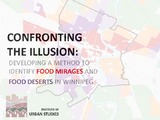| dc.contributor.author | Wiebe, Kyle | |
| dc.contributor.author | Distasio, Jino | |
| dc.contributor.author | Shirtliffe, Ryan | |
| dc.date.accessioned | 2016-06-23T18:47:34Z | |
| dc.date.available | 2016-06-23T18:47:34Z | |
| dc.date.issued | 2016-06 | |
| dc.identifier.uri | http://hdl.handle.net/10680/1205 | |
| dc.description | i, 20 p., map | en_US |
| dc.description.abstract | This In-Brief develops a new method to identify both food deserts and food mirages to broaden the understanding of barriers individuals face in accessing food. We find that while food deserts exist in Winnipeg, food mirages are even more prevalent - where affordability is a more common barrier to consuming healthy food than distance is. These results emphasize the need for future policy to target the incomes of individuals and food affordability rather than store locations. | en_US |
| dc.language.iso | en | en_US |
| dc.publisher | Institute of Urban Studies | en_US |
| dc.relation.ispartofseries | IUS In-Brief Series; | |
| dc.rights | info:eu-repo/semantics/openAccess | |
| dc.subject | Food security -- Manitoba -- Winnipeg | en_US |
| dc.subject | Grocery Shopping -- Manitoba -- Winnipeg | en_US |
| dc.subject | Food Supply -- Manitoba -- Winnipeg | en_US |
| dc.title | Confronting the Illusion: Developing a Method to Identify Food Mirages and Food Deserts in Winnipeg | en_US |
| dc.type | Article | en_US |



